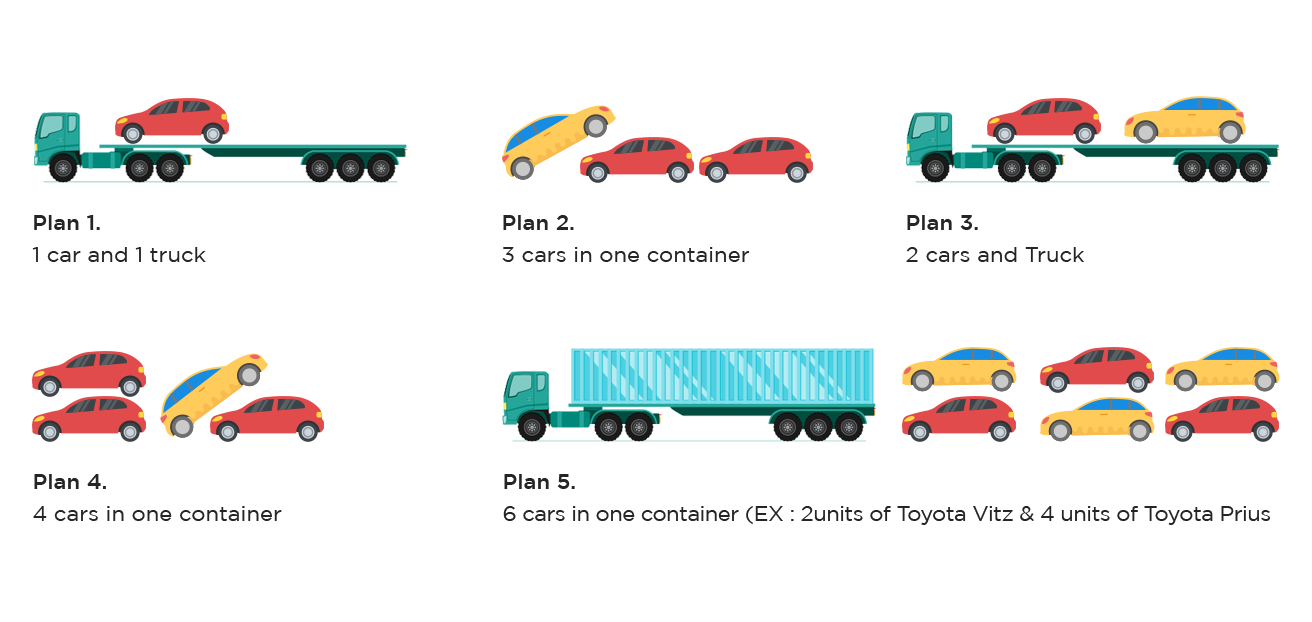At Unet, we know that our transaction with our customers doesn’t end with the end of an auction or finalization of a sale. As we are headquartered in Japan, there is a high likelihood you will require assistance in shipping your newly purchased vehicle/vehicles to your home.
Unsure how to proceed? We can help! We are proud to partner with a network of reliable, experienced shipping companies that will ensure you receive your vehicle/vehicles on time, on budget, and safely. We will be happy to discuss each option with you to determine which will be best for your location, as well as which method will be the timeliest, most cost-effective, and stress-free.
The two most common shipping options are "ro-ro" (roll-on/roll-off), and shipping by the container:
The roll-on/roll-off (ro-ro) option is the most commonly selected for single vehicle delivery. It involves employing a ship designed to carry wheeled vehicles, including cars, trucks, semi-trucks, and railroad cars. The vehicles are driven on, then off the ship as they are, under their own power. Cargo is measured in cubic meters (CMB) by multiplying the length, width, and height of the vehicle, instead of by weight. A benefit of this method is that as long as a ramp and trailer head are available, additional machinery (e.g., cranes) are not necessary. This method also guarantees the arrival and departure dates for your vehicle and is ideal for those on a specific timeline. Additionally, ro-ro vehicles can be delivered to an underdeveloped port. This method is easier, faster, more convenient, and less expensive than using a shipping container.
The ro-ro option does not require a larger vehicle (e.g., boat or semi-trailer truck) to be taken apart for placement in a shipping container, and your vehicle should be ready-to-drive from the port of delivery saving both time (deconstructing, loading, and reconstructing) and money.
It should be noted, however, that not all countries have this option, especially smaller countries and those without seaport access. Our customer service team will be able to instruct you on how to proceed. Another drawback of this option is the element of safety. Though, for the most part, this is a safe option, there is an increased risk for accidents and damage to a vehicle, especially during the loading and unloading process. Additionally, as the vehicle must remain unlocked for access by shipyard staff, there may be a risk of interior damage, robbery, or vandalism while the vehicle is unattended.
The ro-ro option may not be ideal for those shipping collector's items or classic cars, as they will be more vulnerable to damage, may be unfamiliar to the mechanical loading and unloading them, and they may pose liability risks (e.g., leaks, electrical concerns), which may result in a refusal to ship them.
It is also important to note that in order to use the ro-ro shipping option, the vehicle purchased must be in an operative condition, and may not contain any personal belongings, including any spare parts purchased. Because there is no way to assess the damage incurred before shipment, vehicles may only be insured for total loss, which should be considered before selecting this option.

Container shipments are a better option for customers purchasing multiple vehicles. These ships carry their loads in individual truck-sized containers coming in 20-foot and 40-foot sizes. Generally, one car can fit in a 20-foot container, and up to six can fit into a 40-foot container, depending on size (2-3 for larger vehicles like an SUV). It is strongly recommended that luxury vehicles and classic vehicles are shipped in separate containers by themselves. For cost-effectiveness, it is recommended that customers purchasing multiple vehicles load them into a 40-foot container. To reduce costs for individual vehicles, a customer may choose to share the cost of a container.
Because your vehicle/vehicles are inspected before loading, they can be insured for damages incurred before and after transport, and it does not need to be in operable condition to be transported, unlike the ro-ro option.
The benefits of using a shipping container include the fact that they can be sent to nearly any port in any country in the world, including those where ro-ro is not an option. Freight can be moved from countries without seaports to your delivery location via train or truck. Additionally, there is a reduced risk of damage to your vehicle/vehicles, as they are sealed and secured inside the container. Because it/they are/are stored upon arrival and attended to by the staff of the port of delivery, your vehicle/vehicles will remain safe until it is collected. Another benefit is that spare parts may be sealed in the container with your vehicle, eliminating the need to ship them separately.
One drawback of using a shipping container is that the timeline for delivery is dependent on the containers being filled before shipping, which means all purchase transactions will need to be completed by the time you plan to ship.
The cost for container shipment will vary with the size of the container selected, and the monthly rates charged for shipping (note: rates are usually good for three months, and are then adjusted to match fuel prices). Additional fees will include terminal handling charges (the fees charged by a port for loading and unloading), documentation fees (the fee that covers the cost freight forwarders must pay to carriers), sealing fees (fees that are charged for having to change containers, cleaning, or documentation related to the container seal), and vanning charges. Please contact our customer service team for the pricing for each, as well as insurance coverage. As prices will vary by destination, size of the container, the type of documentation required, and vanning needs, there is no fixed price for this service.
We look forward to working with you to make these arrangements. Our ultimate goal is to ensure you receive your vehicle/vehicles in perfect condition as quickly as possible.